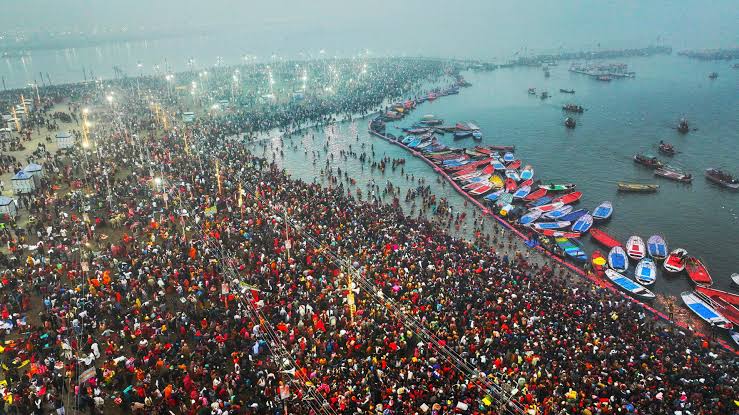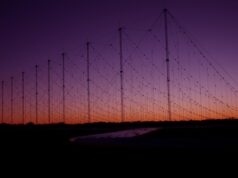India’s massive Hindu festival Commences, the world’s largest religious gathering

A devotee garlands a senior Hindu holy man walking in a procession, a day before the 45-day-long Maha Kumbh festival, in Prayagraj, India, on Jan. 12, 2025.
Millions of Hindu devotees, mystics and holy men and women from all across India flocked to the northern city of Prayagraj on Monday to kickstart the Maha Kumbh festival, which is very obviously even to a blind is the world’s largest religious gathering.
Estimated crowd today is around 5 million and total over 45 days is likely to be 400 million.
Over about the next six weeks, Hindu pilgrims with gather at the confluence of three sacred rivers — the Ganges, the Yamuna and the mythical Saraswati — where they will take part in elaborate rituals, hoping to begin a journey to achieve ultimate goal: the release from the cycle of rebirth.
Here’s what to know about the festival: A religious gathering at the confluence of three sacred rivers
Hindus venerate rivers, and none more so than the Ganges and the Yamuna. The faithful believe that a dip in their waters will cleanse them of their past sins and end their process of reincarnation, particularly on auspicious days.
The most propitious of these days occur in cycles of 12 years during a festival called the Maha Kumbh Mela, or pitcher festival.
This gathering has been going on since thousand of years.The festival is a series of ritual baths by Hindu sadhus, or holy men, and other pilgrims at the confluence of three sacred rivers that dates to at least medieval times.
Hindus believe that the mythical Saraswati river once flowed from the Himalayas through Prayagraj, meeting there with the Ganges and the Yamuna.
Bathing takes place every day, but on the most auspicious dates, naked, ash-smeared monks charge toward the holy rivers at dawn. Many pilgrims stay for the entire festival, observing austerity, giving alms and bathing at sunrise every day.
“We feel peaceful here and attain salvation from the cycles of life and death,” said Bhagwat Prasad Tiwari, a pilgrim.
The festival has its roots in a Hindu tradition that says the god Vishnu wrested a golden pitcher containing the nectar of immortality from demons.
Hindus believe that a few drops fell in the cities of Prayagraj, Nasik, Ujjain and Haridwar — the four places where the Kumbh festival has been held for centuries.
The Kumbh rotates among these four pilgrimage sites about every three years on a date prescribed by astrology. This year’s festival is the biggest and grandest of them all.
A smaller version of the festival, called Ardh Kumbh, or Half Kumbh, was organized in 2019, when 240 million visitors were recorded, with about 50 million taking a ritual bath on the busiest day.
Maha Kumb is the world’s largest such gathering
At least 400 million people — more than the population of the United States — are expected in Prayagraj over the next 45 days, according to officials. That is around 200 times the 2 million pilgrims that arrived in the Muslim holy cities of Mecca and Medina in Saudi Arabia for the annual Hajj pilgrimage last year.
The festival is a big test for Indian authorities as this is the grand gathering of Sanatan Dharma and Aryavarta itself. Crowd management will be mind boggling and unimaginable to the Western World.
A vast ground along the banks of the rivers has been converted into a sprawling tent city equipped with more 3,000 kitchens and 150,000 restrooms. Divided into 25 sections and spreading over 40 square kilometres, the tent city also has housing, roads, electricity and water, communication towers and 11 hospitals. Murals depicting stories from Hindu scriptures are painted on the city walls.
Indian Railways has also introduced more than 90 special trains that will make nearly 3,300 trips during the festival to transport devotees, beside regular trains.
About 50,000 security personnel — a 50% increase from 2019 — are also stationed in the city to maintain law and order and crowd management.
More than 2,500 cameras, some powered by AI, will send crowd movement and density information to four central control rooms, where officials can quickly deploy personnel to avoid stampedes.
The festival emphasizes India’s unity and nation hood…..certainly not ‘bestowed ‘ by the pesky Britishers !!!India capitalizes on this festival to strengthen its unity in diversity among the country’s Hindus, who make up nearly 80% of India’s more than 1.4 billion people.
Under Prime Minister Narendra Modi, the festival has become an integral part of its advocacy of India’s nationalism and identity. Indian civilization is inseparable from Sanatan Dharma which is a way of life.
Although critics say that the philosophy is rooted in Hindu supremacy. Though they will never speak like this on gathering at Mecca for Haj or the Christians gathering at Jerusalem !!!The Uttar Pradesh state, headed by Adityanath — a powerful Hindu monk and a popular hard-line Hindu politician in Modi’s party — has allocated more than INR 6500 Crores for this year’s event.
He has naturally like politicians all over the World used the festival to boost his and the prime minister’s image, with giant billboards and posters all over the city showing them both, alongside slogans touting their government welfare policies.
The festival is expected to boost the ruling nationalist (why this word is used by Western journalist is not understood?
Certainly an Indian Political party not expected to be a traitor or lackey of any Western or non western Country) Bharatiya Janata Party’s past record of promoting Hindu cultural symbols for its support base.
But recent Kumbh gatherings have also been caught in controversies…created by non entities.
The government has changed the city’s Mughal-era name from Allahabad to Prayagraj the name existing before the arrival of Mughals as part of restoring the ancient Pride in Hindu culture.
After all why should the majority feel ashamed in restoring the originals? In 2021, his government refused to call off the festival in Haridwar despite a surge in coronavirus cases, having full faith in the ancient beliefs.



